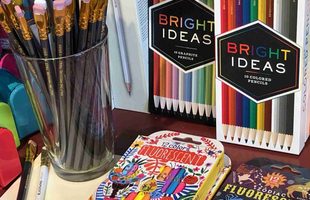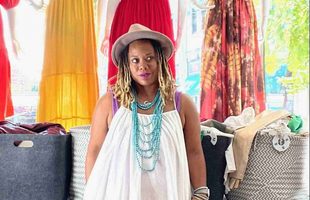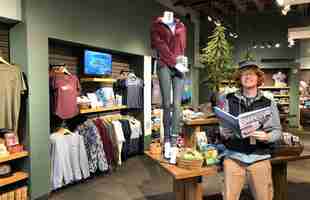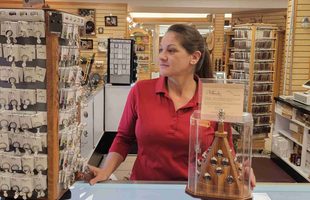At The Museum of Fine Arts in Houston, Texas, Chris Goins, general manager of retail, said jewelry is a top-performing category at the 2,821-square-foot gift shop. “We represent a diverse group of designers, and have a variety of styles from all over the world at accessible price points,” she said. “We sell an Italian line of soft resin art deco earrings in an array of vibrant colors. Most patrons are initially attracted to the different colors and shapes, and they immediately want to try them on. The price is also accessible at $60 a pair. In many cases, clients walk away with purchasing more than a single pair for themselves and as gifts.”
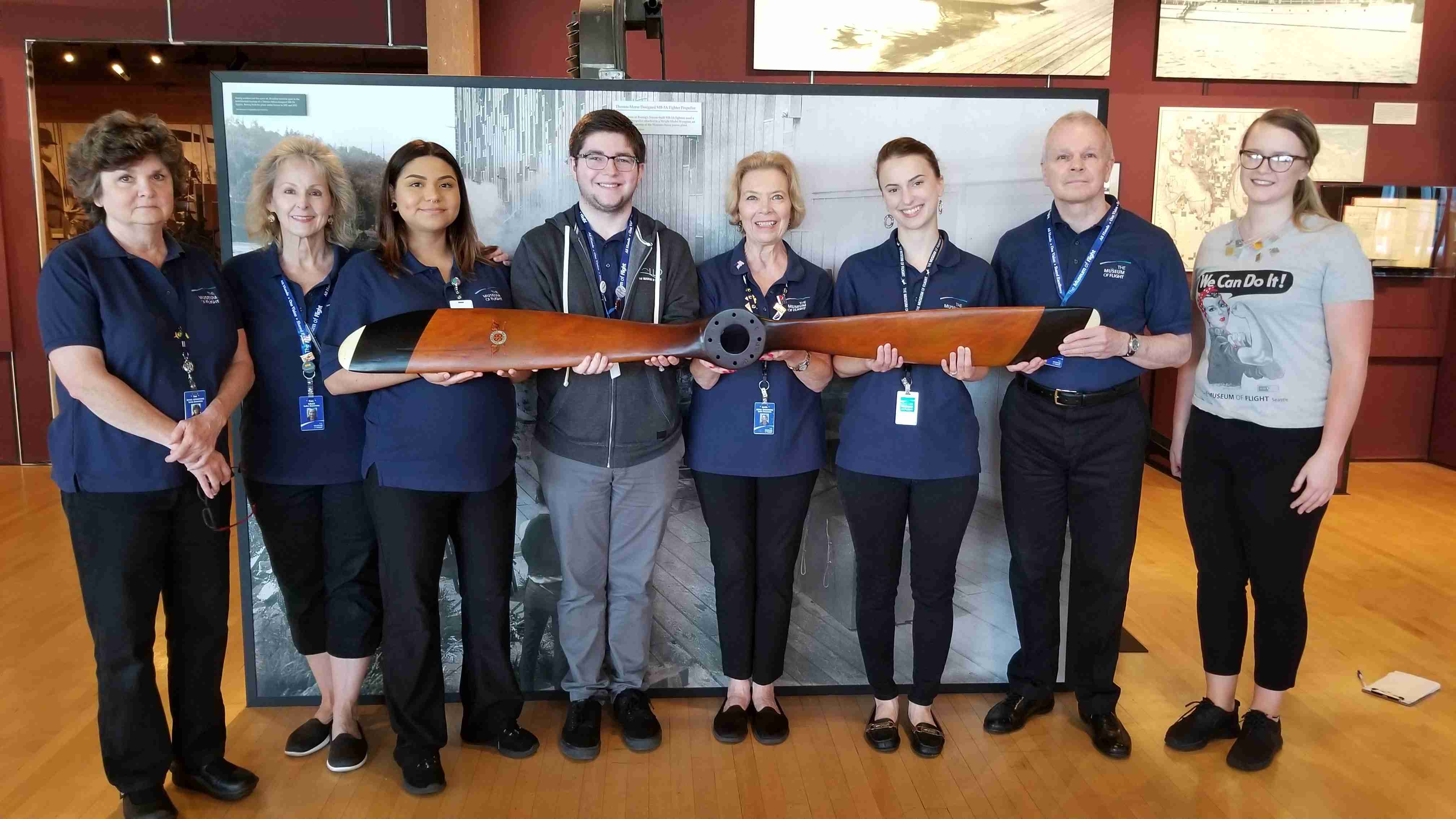 Museum of Flight Sales Associates Sue Walsberg, Pam Cash, Jasmine Jimenez Salas, Garrett Waters, Lynda Eck, Cate Marshall, Brad Hamilton and Paris Puglisi. The retail general manager of this Seattle, Wash., attraction said selling jewelry requires offering many price points.
Museum of Flight Sales Associates Sue Walsberg, Pam Cash, Jasmine Jimenez Salas, Garrett Waters, Lynda Eck, Cate Marshall, Brad Hamilton and Paris Puglisi. The retail general manager of this Seattle, Wash., attraction said selling jewelry requires offering many price points.The National Gallery of Art’s year-to-date best-selling jewelry item is a Murano glass square pendant from San Lorenzo. “Each one is unique, packaged for a gift and priced at $14.95,” said Barbara Lenhardt, general manager and deputy chief of retail at the Washington, DC, museum. The second most popular item is a rainbow bracelet retailing for $16.95. “Both of these items are in self-serve sections in our shops. They are priced right and make an attractive gift.” The gallery has multiple locations throughout the campus averaging approximately 2,700 square feet.
A broad assortment of jewelry at the National Gallery of Art’s gift shops supports and complements the museums’ collection and exhibitions. Contemporary customers seeking edgy designs have gravitated toward French designer Samual Coraux, who is featured in the contemporary shop, said Lenhardt. He uses a combination of Venetian glass, rubber and plastic to create jewelry inspired by art and architecture.
When visiting the gallery’s traditional shop, classic styles of the Renaissance collection are represented in a collection of pearl jewelry. “Many pearl selections are combined with gem stones or cameos to emulate a time of opulence and rebirth in a more current style,” Lenhardt said.
Zach Berry, museum store manager, Tacoma Art Museum, Tacoma, Wash., said best-selling jewelry pieces at the 450-square-foot shop are locally made and handcrafted. The Splendor & Stone brand based in Tacoma usually catches people’s eyes first. “Not only are they beautiful and unique, but they are also very affordable,” he said.
Michael Higdon, retail manager, National Building Museum, Washington, DC, said earrings in the $30 to $40 price range sell well. “The most common element is good design in affordable materials that allow women the opportunity to accessorize and enhance their fashion sense,” he said. The 2,800-square-foot shop garners between $500,000 and $1 million annually.
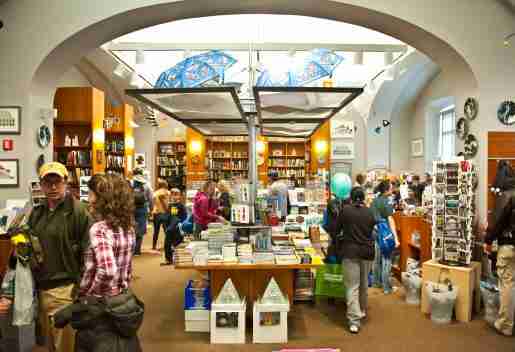 A view of the sales floor at the National Building Museum. Photo by Kevin Allen.
A view of the sales floor at the National Building Museum. Photo by Kevin Allen.For Mary Christensen, retail general manager, Museum of Flight, Seattle, Wash., the key to successfully selling jewelry is offering a wide variety of price points while showcasing the museum’s themes. “We’ve done especially well with under $20 space-related jewelry, such as images of galaxies, silver stars and whimsical airplane jewelry that appeals to younger visitors and those on a budget,” she said. On the other end of the spectrum, two lines of high-end artisan jewelry, Criffin Designs and Wraptillion, both use materials from the aerospace industry making them great conversational pieces.
Best-Selling Home Décor Items
For Lenhardt, popular home décor items range from coffee mugs, prism acrylic tumblers and coasters to high-end mobiles and lamps. “Souvenir décor items that have a direct correlation to the collection and are branded with the gallery’s logo are popular for keepsakes and gift giving,” she said. Higher-end items such as handcrafted mobiles and high design lamps add to an artful lifestyle.
When it comes to home décor, patrons tend to connect with products that represent the Pacific Northwest and the broader western region, such as quilts and shawls from Pendleton Mills. “Whenever a patron is interested in one of these pieces, we highlight the connection to native artists,” Berry said.
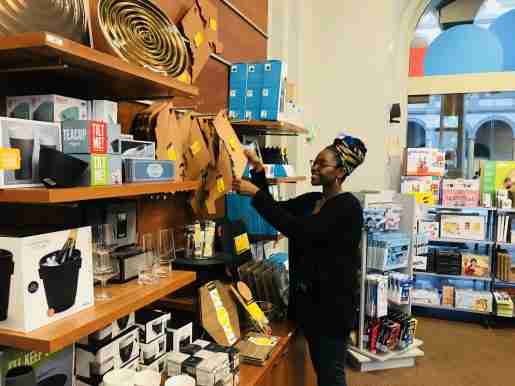 Geronne Florus, visual merchandising/sales associate, the National Building Museum in Washington, D.C., photographed with displays.
Geronne Florus, visual merchandising/sales associate, the National Building Museum in Washington, D.C., photographed with displays.Goins’ shop sells a line of clear and colored acrylic tumblers, champagne glasses, wine glasses and other accessories for the kitchen. “From a distance, they look like glass because the various shapes appear to be hand-cut crystal,” she said. The display fixture contains white opaque plexiglass that emits light from behind it. Acrylic glassware is placed against the wall of this fixture, which illuminates its colors and highlights different sizes and shapes. This draws in guests, who feel compelled to touch and pick up merchandise. They are usually quite surprised to find that it is lightweight and not glass. They look and feel like a fine luxury item, but are at an accessible price point starting at $16.
Wooden propellers, metal signs and globes propelled by magnetic forces fly off the Musuem of Flight gift shop’s shelves. “The propellers speak to an age when aviation was new and gripped everyone’s attention; it was thrilling and dangerous and the possibilities were exciting,” Christensen said. “The metal signs are nostalgic and resonate with customers. Most of them highlight bush flying, Rosie the Riveter or some aspect of flying in small planes. They are colorful and eye catching. Earth globes from MOVA are mesmerizing; they seem to move by magic.”
Getting Guests to Stop and Spend
In order to get guests to stop and spend rather than breeze through her gift shops, Lenhardt said displays are set on the aisles and are specifically positioned to make guests take a look at the assortment. In addition, striking displays along back walls work together to draw customers into the shop.
Cross merchandising and dynamic displays stop people in their tracks to take a closer look. “We do our best to feature products that are directly related to the collection, as well as events taking place in our museum and city,” Lenhardt said. “When engaging with customers, we ask them questions about their visit to find out what brought them in and then highlight relevant items.”
Berry said products are set up in a way to encourage customers to walk through. “Instead of keeping similar items close to one another, we mix things up,” he said. “This allows for us to walk with patrons and show them new or different items. We also change our front display regularly. It might not always feature a specific sale or new product, but it gives us a chance to creatively promote items which patrons may not have seen.”
Berry said that customers are attracted to the shop’s jewelry because it is merchandized in interesting ways. “We don’t merely have it sitting on a stand or rack; we create stories in our displays, incorporating unique fixtures, found objects and recycled materials,” he said.
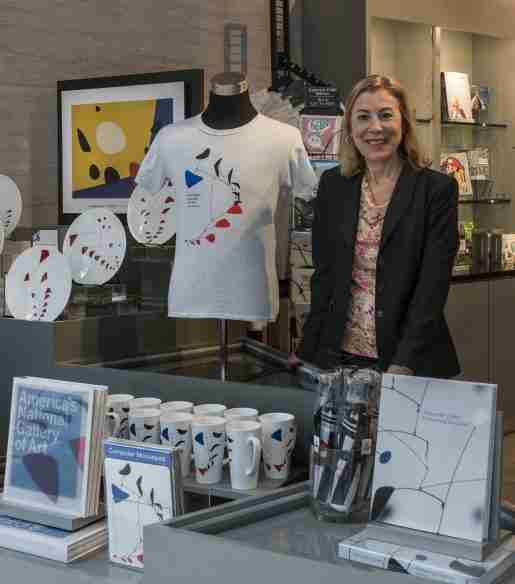 Barbara Lenhardt, general manager of retail, The National Gallery of Art, Washington, D.C. So far, the year’s best-selling jewelry item is a Murano glass square pendant from San Lorenzo.
Barbara Lenhardt, general manager of retail, The National Gallery of Art, Washington, D.C. So far, the year’s best-selling jewelry item is a Murano glass square pendant from San Lorenzo.At The Museum of Fine Arts; shop, visual billboards act as messaging and engage viewers. “Subtle and impactful visual references make viewers stop and look—not only to see the merchandise on display, but to understand the narrative that is taking place,” Goins said. “Our visual team takes great pride in creating a fun shopping environment, but more importantly it also enhances the museum visitor’s entire experience.”
Higdon practices what he calls “drive by engagement.” “This is the next step beyond greeting customers as they enter a store,” he said. “If someone breezes through the store and briefly glimpses at a product, you swoop in and drop a small tidbit or fact about it in the hopes that it will cause them to stop and engage with the product longer.”
Christensen said visitors are often overwhelmed with visual stimulation by the time they get to the museum’s store, so creating bold and on-point displays to create focus helps them slow down and take the shopping experience one moment at a time. Because many guests visit weekly, Christensen rotates window displays and themes to keep product fresh. The 3,200-square-foot shop garners $2.4 million annually.
(Please visit www.sgnmag@kanec.com for a sidebar to this article titled “How Museum Staff Can Promote Higher-Priced Items.” )
